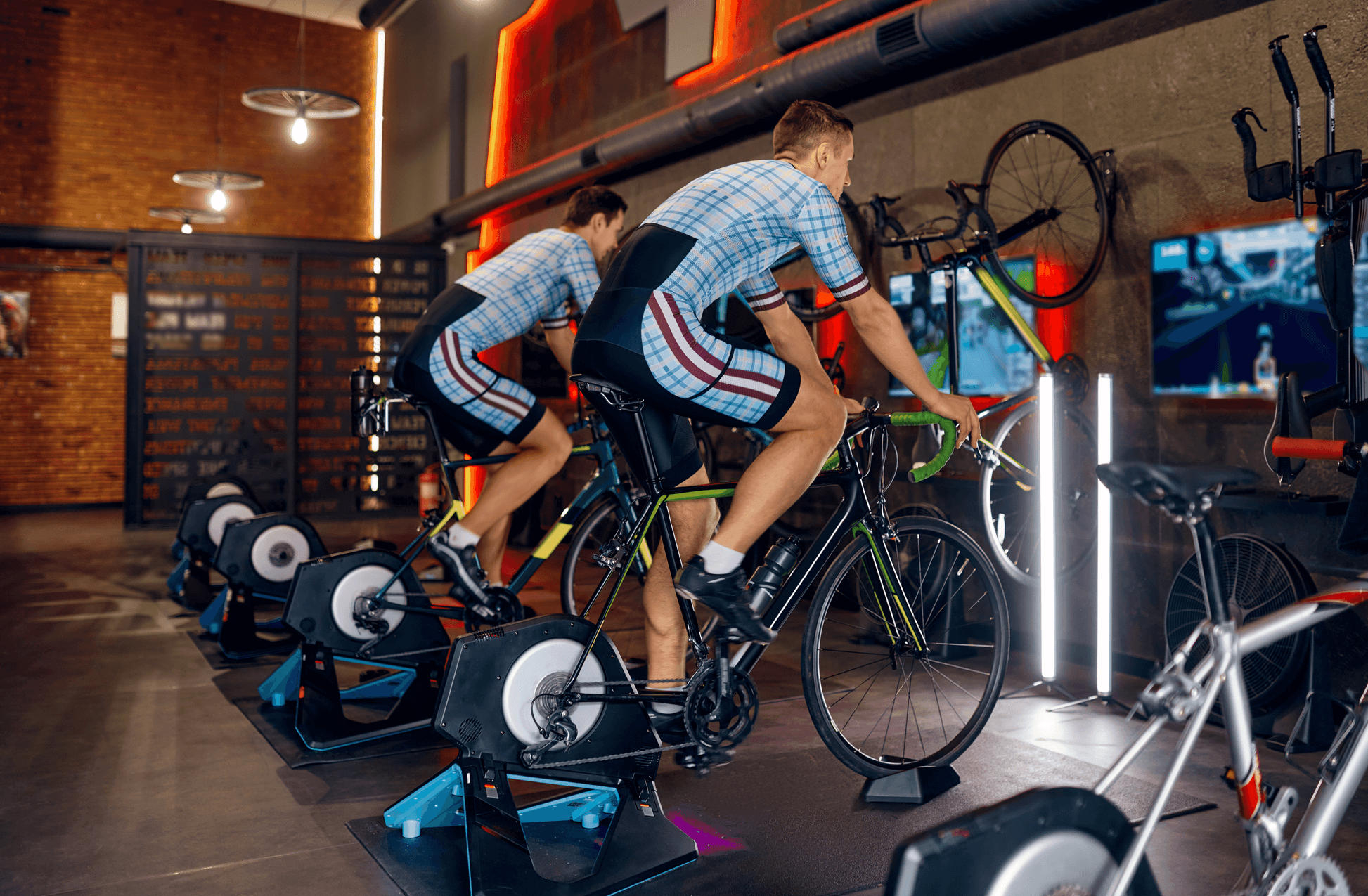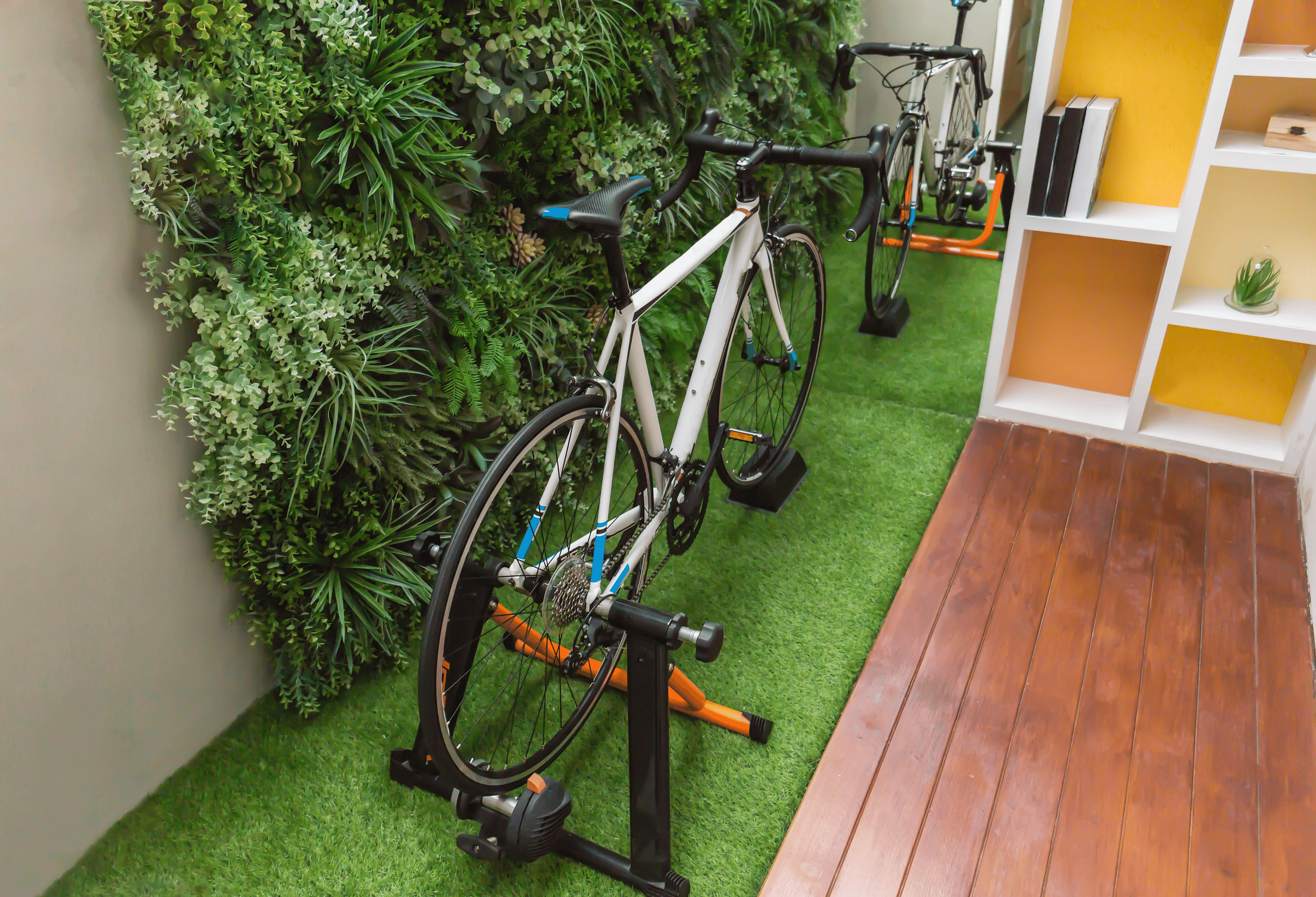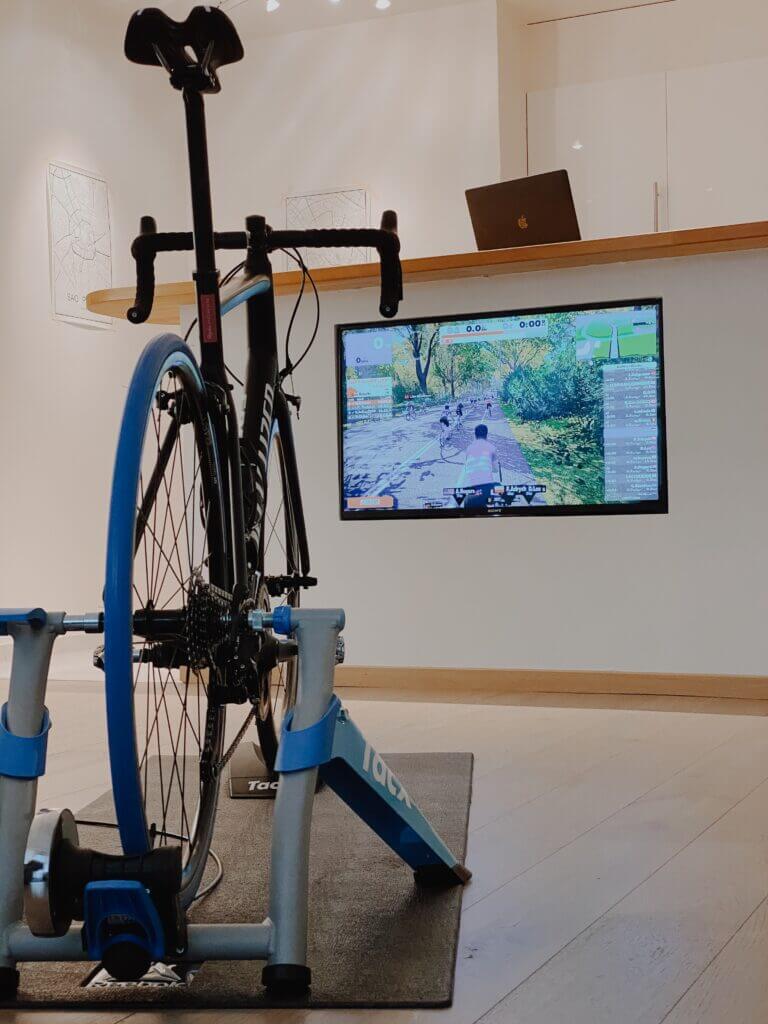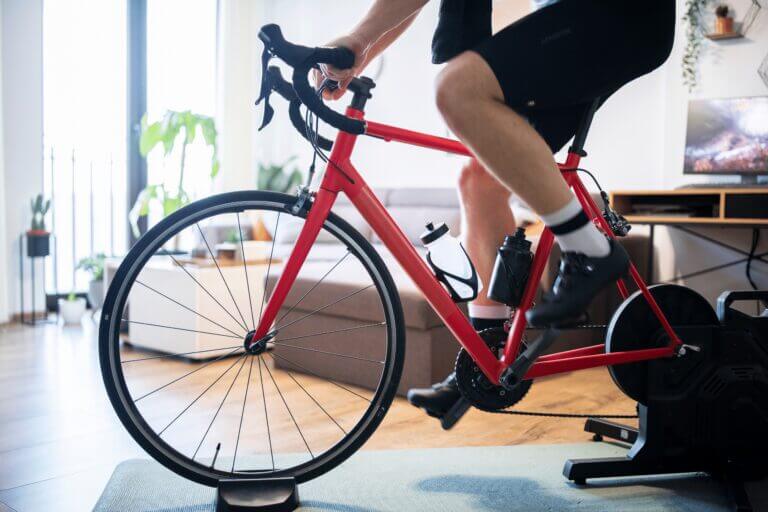Cycling enthusiasts, both experienced riders and beginners alike, often find themselves facing a common dilemma: how to maintain training consistency and stay fit when outdoor cycling conditions outside are less than ideal?
One solution that has gained significant popularity is the use of an indoor bike trainer.
The indoor bike trainer, also commonly referred to as a turbo trainer, is a popular indoor cycling tool that allows cyclists to train and ride their bicycles without leaving the comfort of their homes.
In this article, we will explore the advantages and disadvantages of incorporating a bike trainer into your cycling routine. Whether you’re a seasoned cyclist or just starting out, understanding the pros and cons of using a bike trainer can help you make an informed decision about whether it’s the right tool for you.
Understanding Bike Trainers

Before we dive into the pros and cons, let’s take a moment to understand what bike trainers are. Bike trainers are devices that allow you to convert your outdoor bike into a stationary indoor bike. There are different types of bike trainers available in the market, including direct drive trainers, wheel-on trainers, and rollers. Each type has its own unique features and benefits.
Direct drive trainers, for example, replace your bike’s rear wheel and directly connect to the bike’s drivetrain. This provides a more realistic road feel and accurate power measurement. Wheel-on trainers, on the other hand, attach to your bike’s rear wheel and provide resistance through a roller that contacts the tire. Rollers consist of three drums on which you balance your bike, requiring more skill and balance.
The Pros of Using a Bike Trainer

Weather Independence and Convenience
One of the significant advantages of using a bike trainer is weather independence. With a bike trainer, you can cycle indoors regardless of external weather conditions. Rain, snow, or extreme heat won’t interfere with your training.
Additionally, indoor cycling offers unparalleled convenience. You can hop on your bike at any time without worrying about planning routes, dealing with traffic, or safety concerns on the road. This flexibility allows you to fit your workouts seamlessly into your busy schedule, making it easier to prioritize your cycling training and stay committed to your fitness goals.
Controlled Environment for Specific Training Goals
Bike trainers provide a controlled environment for specific training goals. Whether you’re focusing on interval training, power-based workouts, or following a structured training plan, a bike trainer offers the ideal setting. You can precisely target and measure your efforts, adapting the resistance to match your desired intensity.
Furthermore, many bike trainers have the ability to simulate hill climbs and specific terrains, allowing you to prepare for races or improve your performance by mimicking real-world cycling conditions.
With a bike trainer, you have precise control over resistance levels, allowing you to target and measure your efforts accurately. This level of control is particularly beneficial for interval training, where you alternate between high-intensity efforts and recovery periods.
You can adjust the resistance to match your desired intensity, ensuring that you push your limits and challenge yourself effectively.
Furthermore, many bike trainers have advanced features that allow them to simulate hill climbs and specific terrains. This feature is invaluable for preparing for races or improving your performance by mimicking real-world cycling conditions.
By incorporating simulated hills or challenging terrains into your training sessions, you can build strength, improve endurance, and develop the necessary skills to tackle any outdoor cycling route with confidence.
Safety and Injury Prevention
Indoor cycling on a bike trainer significantly reduces the risk of accidents or injuries associated with outdoor cycling. With no traffic, pedestrians, or road hazards to contend with, you can train in a safe environment.
This makes bike trainers particularly beneficial for individuals recovering from injuries or those looking to prevent joint strain.
For cyclists recovering from injuries or dealing with joint issues, bike trainers offer a low-impact alternative that minimizes strain on the body. The stationary nature of indoor cycling reduces the impact on joints, making it an ideal choice for rehabilitation or as a supplementary training method to complement outdoor rides.
Moreover, indoor cycling sessions provide an opportunity to concentrate on pedaling technique and form correction without distractions. In a controlled environment, you can analyze your body positioning, pedal stroke, and cadence, making adjustments to improve efficiency and reduce the risk of overuse injuries.
By refining your technique indoors, you can transfer these improvements to your outdoor rides, enhancing your overall cycling performance and reducing the chances of injury.
The Cons of Using a Bike Trainer

Lack of Real-World Elements
While bike trainers offer many advantages, they lack the real-life variables that come with outdoor cycling. When cycling indoors, you miss out on elements such as wind, road conditions, and elevation changes.
These elements play a crucial role in skill development, balance, and bike handling abilities. As a result, additional efforts may be required to refine these aspects of your cycling when exclusively training indoors.
Outdoor cycling provides the opportunity to adapt to changing terrains, navigate turns, and adjust to environmental factors. It requires constant engagement and decision-making, which contribute to a more dynamic and immersive cycling experience. In contrast, indoor cycling on a bike trainer can feel static and predictable.
To mitigate this limitation, it’s important to incorporate specific training exercises and drills that target balance, bike handling skills, and agility. This can involve practicing standing on the bike, working on cornering techniques, or incorporating balance exercises into your routine.
Supplementing your indoor cycling sessions with occasional outdoor rides can also help bridge the gap between the controlled environment of a bike trainer and the unpredictability of real-world cycling.
Monotony and Motivation Challenges
Indoor cycling can sometimes become monotonous due to the lack of changing scenery and social interaction that outdoor cycling provides. The repetitive motion of pedaling in one place can lead to decreased motivation over time.
To combat monotony and keep your indoor cycling workouts exciting and engaging, it’s important to introduce variety into your training sessions. Consider incorporating different types of workouts, such as interval training, endurance rides, or tempo efforts.
Vary the duration and intensity of your sessions to keep things interesting and challenge yourself. You can also experiment with different training programs or virtual riding platforms that offer virtual courses and multiplayer capabilities, allowing you to compete or ride alongside other cyclists from the comfort of your home.
In addition, creating a dedicated indoor cycling space that is visually appealing and comfortable can contribute to a more enjoyable experience. Set up your bike trainer in a well-lit area, play your favorite music or podcasts, and consider using a fan or opening a window for ventilation.
Engaging in group training sessions or connecting with fellow cyclists online through forums or social media platforms can also help maintain motivation and provide a sense of community.
Physical Discomfort and Heat Generation
Prolonged stationary cycling can result in physical discomfort. Sitting on a bike saddle for extended periods can lead to saddle soreness, numbness, and muscle fatigue. Additionally, intense indoor workouts can generate significant heat, leading to discomfort and excessive sweating.
To address these concerns, it’s important to prioritize comfort during your indoor cycling sessions. Ensure that your bike is properly fitted to your body, taking into account factors such as saddle height, saddle position, and handlebar reach.
Investing in a comfortable saddle that suits your anatomy can significantly reduce discomfort and the risk of saddle-related issues.
In addition, consider incorporating regular breaks and stretching exercises during longer indoor cycling sessions to alleviate muscle fatigue and prevent stiffness. It’s also advisable to incorporate cooling solutions, such as using fans or opening windows, to regulate temperature and enhance comfort during intense workouts.
Wearing moisture-wicking clothing and using towels or sweat guards to manage excessive sweating can also help improve your overall comfort level.
Optimizing Your Bike Trainer Experience

Choosing the Right Bike Trainer
Selecting the right bike trainer is crucial to optimizing your indoor cycling experience. Consider your individual needs and preferences when choosing between direct drive trainers, wheel-on trainers, or rollers.
Factors such as budget, noise level, space requirements, and connectivity options should be taken into account. Nowadays, many cyclists prefer smart trainers that offer Wi-Fi connectivity and integration with online training platforms for a more immersive and interactive experience.
Accessories and Equipment
Enhance your indoor cycling setup by utilizing essential accessories. A front wheel riser block helps maintain proper bike alignment, a trainer mat reduces noise and protects your floor, and a sweat guard protects your bike from corrosion caused by excessive sweating.
Prioritize a quality bike fit and ensure your bike is properly set up to optimize comfort and performance during indoor cycling sessions.
Incorporating Variety into Indoor Workouts
To combat monotony and keep your indoor cycling workouts exciting and engaging, incorporate variety into your training sessions. Interval training, alternating between high-intensity efforts and recovery periods, is an effective way to challenge yourself and improve your fitness.
Explore virtual riding platforms, such as Zwift, that offer virtual courses, multiplayer capabilities, and training programs designed to add excitement to your indoor cycling experience.
Smart trainers equipped with Wi-Fi connectivity allow seamless integration with online training platforms like Zwift. By connecting your smart trainer to these platforms, you can enjoy a virtual cycling experience where your effort on the bike translates to your avatar’s movement in the digital world.
The platform offers various terrains, including climbs and descents, and provides real-time data on your speed, power, and heart rate. This integration between your smart trainer and virtual training platform adds an extra layer of excitement, motivation, and social interaction to your indoor cycling workouts.
In addition to virtual platforms like Zwift, there are other online training apps and platforms available that offer similar features and benefits. Explore different options to find the one that best suits your preferences and goals, allowing you to maximize the potential of your smart trainer and create engaging, immersive indoor cycling experiences.
Entertainment Options
Indoor cycling provides an excellent opportunity to enjoy entertainment while you ride. Set up your indoor cycling space in a way that allows you to incorporate entertainment options such as watching TV shows, movies, or listening to music.
Consider positioning your bike trainer in front of a television or computer screen, allowing you to stream your favorite TV shows or movies while you pedal away. This can help make your indoor cycling sessions more enjoyable and distract you from the effort, particularly during longer rides or endurance workouts.
Alternatively, create a playlist of energetic and motivating music to accompany your rides. Music can significantly enhance your mood and help you maintain a steady cadence and intensity during your workouts. Choose songs with a beat that matches your desired pedaling pace and experiment with different genres to find what motivates you the most.
Additionally, you can explore podcast episodes, audiobooks, or motivational speeches to listen to while cycling. These options provide mental stimulation and can help pass the time during your indoor cycling sessions.
FAQ About Bike Trainers
Are bike trainers noisy?
The noise level of bike trainers can vary depending on the type and model. Direct drive trainers tend to be quieter compared to wheel-on trainers. However, many modern trainers incorporate noise-reducing technologies to minimize sound during indoor cycling sessions.
Will my bike fit on any bike trainer?
Most bike trainers are compatible with a wide range of bikes, including road bikes, mountain bikes, and hybrids. However, it’s essential to ensure compatibility by checking the specifications and compatibility requirements provided by the manufacturer.
Can I use a bike trainer for recovery rides?
Bike trainers can be used for recovery rides as they provide a controlled environment where you can cycle at a lower intensity. Adjust the resistance to a comfortable level and focus on gentle pedaling to aid recovery and improve blood circulation without excessive strain on the body.
Can I use a bike trainer with a power meter?
Yes, many bike trainers are compatible with power meters. This allows you to accurately measure your power output during indoor cycling sessions, providing valuable data for tracking your progress and optimizing your training.
How much do bike trainers typically cost?
The cost of bike trainers can vary depending on the type, features, and brand. Basic wheel-on trainers can start around $100 (€85), while more advanced direct drive smart trainers can range from $500 (€425) to $1,500 (€1,275) or more. It’s important to consider your budget, training needs, and desired features when determining the right bike trainer for you.

